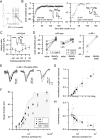Nonlinear Spatiotemporal Integration by Electrical and Chemical Synapses in the Retina
- PMID: 27068789
- PMCID: PMC4840068
- DOI: 10.1016/j.neuron.2016.03.012
Nonlinear Spatiotemporal Integration by Electrical and Chemical Synapses in the Retina
Abstract
Electrical and chemical synapses coexist in circuits throughout the CNS. Yet, it is not well understood how electrical and chemical synaptic transmission interact to determine the functional output of networks endowed with both types of synapse. We found that release of glutamate from bipolar cells onto retinal ganglion cells (RGCs) was strongly shaped by gap-junction-mediated electrical coupling within the bipolar cell network of the mouse retina. Specifically, electrical synapses spread signals laterally between bipolar cells, and this lateral spread contributed to a nonlinear enhancement of bipolar cell output to visual stimuli presented closely in space and time. Our findings thus (1) highlight how electrical and chemical transmission can work in concert to influence network output and (2) reveal a previously unappreciated circuit mechanism that increases RGC sensitivity to spatiotemporally correlated input, such as that produced by motion.
Copyright © 2016 Elsevier Inc. All rights reserved.
Figures







Comment in
-
Mind the Gap Junctions: The Importance of Electrical Synapses to Visual Processing.Neuron. 2016 Apr 20;90(2):207-9. doi: 10.1016/j.neuron.2016.04.007. Neuron. 2016. PMID: 27100191 Free PMC article.
References
-
- Alle H, Geiger JR. Combined analog and action potential coding in hippocampal mossy fibers. Science. 2006;311:1290–1293. - PubMed
Publication types
MeSH terms
Substances
Grants and funding
LinkOut - more resources
Full Text Sources
Other Literature Sources
Molecular Biology Databases
Miscellaneous

